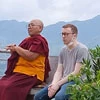Pharping, 21 kilometer south from Kathmandu is sacred site of Yanglesho where Guru Padmasambhava attained level of a Mahamudra Vidyadhara. Pharping town is a thriving Newari town that’s ancient Buddhist pilgrimage sites have been taken over by large numbers of Tibetans. However more specifically it is referring to two caves in which Guru Rinpoche is said to have meditated. One is located on the hillside behind and above Pharping, commonly known as Asura Cave or the 'Upper cave of Yangleshö'. The other one is located slightly below Pharping, about a five minute walk outside of town and known as 'Lower cave of Yangleshö' or simply Yangleshö.
Pharping, where Guru Padmasambhava attained the level of a Mahamudra vidyadhara. Yangleshö is thus, according to Katok Rigdzin Tsewang Norbu, considered to be for Vajrayana practitioners as important as Bodhgaya because it is where the second buddha Guru Padmasambhava attained the state of enlightenment. Every year Chökyi Nyima Rinpoche leads several seminars and retreats in Asura Cave monastery in Pharping. Pharping has not only been blessed by Guru Rinpoche, it has been also visited by many great beings, like long term resident Marpa Lotsawa, who practiced, made offerings, ganachakra feasts, aspiration prayers and so on.
Sites to see in Pharping
There are two major practice caves in Pharping blessed by Guru Rinpoche: the Asura cave and the Yangleshö cave. At the bottom of the flight of stairs climbing up to the Asura cave is an old and important Vajrayogini temple, the Pharping Vajravarahi temple. This is one of the four or five Vajrayoini temples of the Kathmandu valley. The others are located in Sankhu, near Swaymbhunath, below the hill of Pashupatinath (Guhyeshwari), and in Chapagaun. They start towards the end of the village, at Ralo Rinpoche's monastery and start by a shrine containing a self-arisen Tara on the side of an image of Ganesha. To the south of the village is the temple of Dakshinkali, one of the four Kalis surrounding the Kathmandu valley. Pharping also has several monasteries, temples and retreat centers, including Chatral Rinpoche's monastery, and the Palyul Retreat Centre, which is the residence of Khenpo Namdrol Rinpoche and home to the Rigpa Shedra. 
Asura Cave
Tour Itinerary
Drive to Pharping. It is 20 kilometer south from Kathmandu and takes about 1 hour. Drive with private car, we visit Asura cave and Yanglesho cave, both blessed by Guru Padmashambhava. Visit Pharping monastery, Parphing Bhajrayogini temple and surrounding area covered by prayers flags. Option to drive further to Dakshinkali temple, a Hindu goddess Kali. It is about 2 kilometer further from Pharping village. There are many other Monastery around the village, if you wish to visit. Drive back to Kathmandu with the same car.
Pharping Tour Schedule
Start from your hotel by 9 am is suggested, you still can choose your time.
09:00AM: Our car and guide will pick up you from your hotel and start driving to Pharping. This is the suggested time to starts, but you can choose your own time to follow
10:00AM: 21 kilometer takes 1 hour. Drive through beautiful landscape, local villages, valley view. Reach at Pharping and start visiting around.
Visit the Asura Cave
Monasteries and arnoud the Asura Cave
Place of prayer flag at the top of the cave
Vajrayogini temple
Yangleshö cave and monastery
Statue of Guru Rinpoche in Dallu village
Explore around the Dallu village
Visit Taudaha on the way back
Drop to Kathmandu
You will be back in Kathmandu by 2 - 3 pm.

Yangleshö cave also called Shesh Narayan in Pharping
Option to include Dakchhinakali temple in Pharping tour
Pharping tour has option to add Dakchhinakali temple. It is in the same tour cost. Dakchhinkali temple is about 2 kilometer from Pharping. It is temple dedicated to the Goddess Kali is one of the major Hindu temples in Nepal.It’s believed that she likes to have fresh animal blood two times a week (Thursday and Saturday), therefore, this is a popular temple for live sacrifices twice a week. People come from all over the Kathmandu Valley to offer roosters and male goats to the goddess in hopes of having any evil removed from their lives. Dakchhinakali temple has also the same value as Pashupatinath temple and Manakamana Temple in Nepal. Mother Dakshinakali is the most popular form of Kali. She is the benevolent mother, who protects her devotees and children from mishaps and misfortunes.
A video about Asura cave, Pharping. The place of Guru Rinpoche or Padmashambhava






